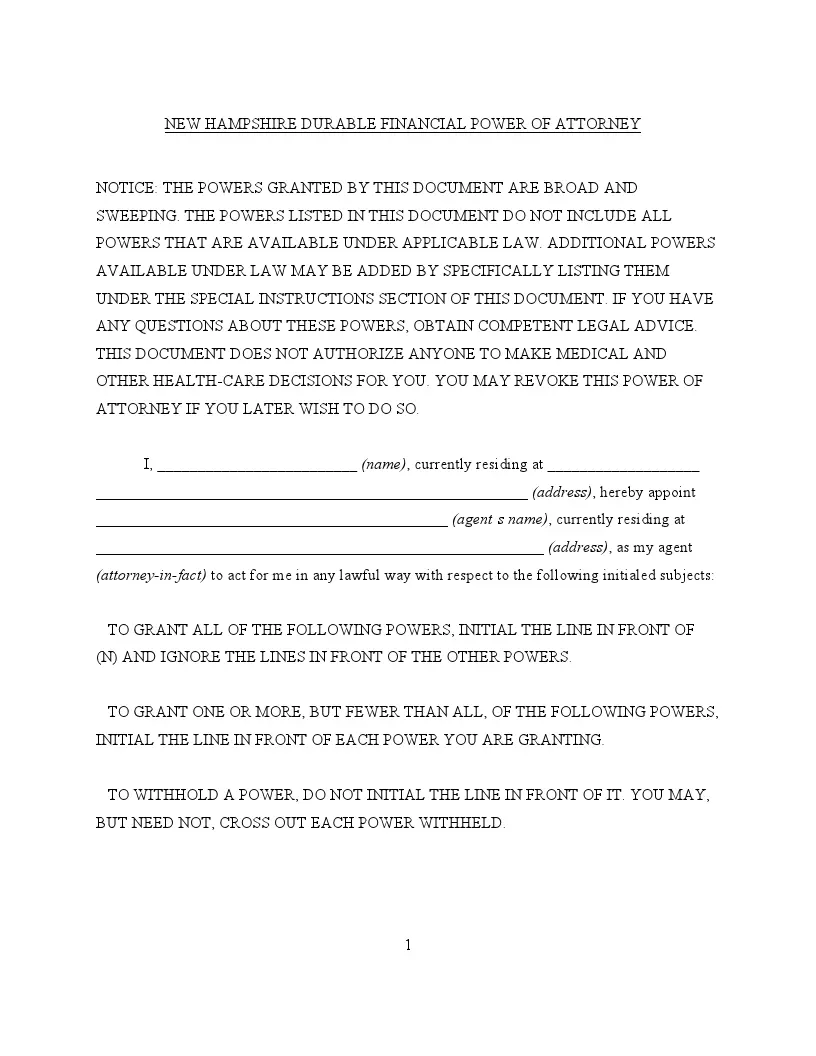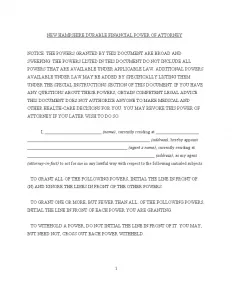Free New Hampshire Durable Power of Attorney Form
The New Hampshire durable power of attorney enables a person (referred to as the “principal”) to designate the “agent” or “attorney-in-fact” to handle their affairs should they lose the ability to manage them due to incapacity. This enduring feature sets it apart from other non-durable forms that become invalid once the principal is deemed incapacitated.
The principal has the flexibility to assign either extensive or specific powers to the agent. These powers include managing financial accounts, overseeing real estate dealings, and making personal life decisions. Typically, the durable power of attorney becomes effective immediately upon signature unless otherwise directed by the principal in the document. It remains valid until the principal passes away or chooses to cancel it sooner. Revocation of the power of attorney is permitted as long as the principal retains mental capacity.
This document is useful in estate planning to ensure that the principal’s affairs are managed according to their wishes should they become incapacitated. Check out all New Hampshire POA templates if you need other state-specific forms.

Build Your Document
Answer a few simple questions to make your document in minutes
Save and Print
Save progress and finish on any device, download and print anytime
Sign and Use
Your valid, lawyer-approved document is ready
New Hampshire Signing Requirements and Laws
In New Hampshire, the creation and execution of a durable power of attorney (POA) are governed by specific statutes to ensure legal validity and protect all parties involved. According to New Hampshire Revised Statutes, Section 564-E:105, for a general power of attorney to be considered legally binding, several criteria must be met during the signing process:
- A power of attorney must be physically signed by the principal or by another person in the principal’s presence and direction. It excludes electronic signatures for the initial execution.
- The signature must be acknowledged before a notary public or individual legally authorized to take acknowledgments. Notarization formalizes the document, ensuring that the principal’s signature is verified and the document is recognized as legally binding.
Under Section 564-E:104, the statute specifies that a POA is considered durable by default unless explicitly stated otherwise in the document itself. It means that the power remains in effect even if the principal becomes incapacitated, ensuring continuity in managing the principal’s affairs without interruption.
Furthermore, Section 564-E:110 outlines the scenarios under which a power of attorney or an agent’s authority may terminate. These include the death or incapacitation of the principal (if the POA is not durable), revocation by the principal, or completion of the POA’s specified purpose. Additionally, the agent’s authority can end if the principal revokes it, the agent dies or becomes incapacitated, or during certain family law events if the agent is married to the principal.
New Hampshire Durable Power of Attorney Form Details
| Document Name | New Hampshire Durable Power of Attorney Form |
| Other Names | New Hampshire Financial Durable Power of Attorney, NH DPOA |
| Relevant Laws | New Hampshire Revised Statutes, Section 564-E:105 |
| Signing Requirements | Notary Public |
| Avg. Time to Fill Out | 10 minutes |
| # of Fillable Fields | 37 |
| Available Formats | Adobe PDF |
Popular Local Durable POA Forms
Durable POA documents are used in each and every state. Take a look at other popular DPOA forms frequently filled out by Americans.
Steps to Complete the Form
Following these steps will help ensure that your durable power of attorney form is properly completed and legally effective, according to New Hampshire law.
1. Identifying the Principal and Agent
Begin by entering your full name and address as the principal. You’ll also need to provide the full name and address of the person you designate as your agent. Make sure the information is accurate and reflects your current residence.
2. Granting Authority
You will encounter several clauses that specify the powers you are granting to your agent. These range from managing financial transactions to handling real estate dealings and more. You must initial next to each power you want to grant to confirm your choices. If you do not initial next to a specific power, your agent will not possess that authority.
3. Special Instructions
If you have specific instructions for your agent that are not covered by the standard clauses, you can list them in the section provided for special instructions. These might include limitations or additional responsibilities you want to assign.
4. Execution of the Document
After reviewing the powers and instructions, you need to sign and date the document in the presence of a notary. This section typically requires your signature and the date and location (city and state) where you sign the form.
5. Notarization
The final step is to have the form notarized. This involves signing the document before a notary public, who will confirm your identity and your understanding of the document’s significance. The notary will also sign and seal the document, validating its authenticity.
6. Agent’s Acknowledgment
The agent must also read and acknowledge their understanding of the responsibilities and limitations of their power. This acknowledgment is usually done in a separate section where the agent affirms their duties and signs in front of a notary.

Listed here are various other New Hampshire documents filled out by our users. Try our step-by-step builder to customize these forms to your needs.
Download a Free New Hampshire Durable Power of Attorney Form
